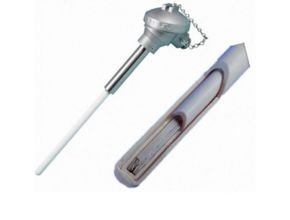About Silver Instrument Platinum-rhodium thermocouple assembly Sensor
A thermocouple is an electrical device used as a sensor for temperature measurement. This device senses low to high temperatures in the form of voltage changes and displays the temperature digitally by calculating the voltage changes. It was discovered in 1821 by Thomas Seeback and thus has been serving the function since then. The self-powered thermocouple can measure temperatures between -300 and 4000F.

However, this range varies according to different types of thermocouples. The advanced digital thermocouple comes in different styles. This styling varies from simple wires to thermocouples with probes and beaded wire thermocouples. Thermocouple differs from other temperature-sensing devices in their constituency and applications. They are used mostly for high-temperature measurements in industries whereas other sensors like a thermometer are rarely used commercially.
Description Of Platinum-rhodium Thermocouple Assembly Sensor
It is an assembly of thermocouples in which the dissimilar metal wires are made up of platinum metal and rhodium metal respectively. It’s a noble metal thermocouple that provides resistance from corrosion and oxidation in high-temperature conditions. Three preparations of this thermocouple are made that differ on the base of concentration of the metals.
This includes type S, type R and type B PR thermocouples. All these types offer high stability and greater precision in temperature measurements. Platinum-rhodium thermocouple assembly can be used in vacuum conditions for a short time. They are widely used in refining, cosmetic and oil, and gas industries for temperature measurements.
Sources: www.silverinstruments.com
Read More Article :
- Flange resistance thermometer – TP 17 / TP 18 Hengesbach
- Delta Mobrey Temperature Measurement
- Hengesbach TP 19 Flange Resistance Thermometer
- Tube Resistance Thermometer TP 21 Hengesbach
- Hengesbach Resistance Thermometer with Screw Connection TP 26




